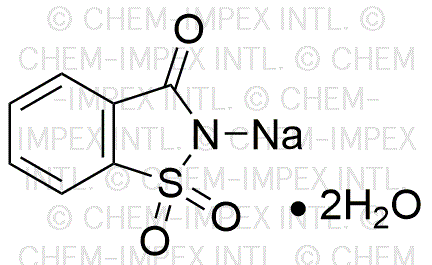Saccharin sodium salt dihydrate is widely utilized in research focused on:
- Food and Beverage Industry: As a low-calorie sweetener, it is commonly used in diet sodas, sugar-free candies, and other low-calorie products, providing sweetness without the calories associated with sugar.
- Pharmaceuticals: It serves as a flavoring agent in various medications, improving patient compliance by masking unpleasant tastes in liquid formulations.
- Cosmetics: Its sweetening properties are leveraged in oral care products like toothpaste and mouthwash, enhancing flavor while being safe for use.
- Research and Development: In laboratories, it is often used as a standard for calibrating sweetness in sensory evaluation studies, helping researchers assess the effectiveness of new sweetening agents.
- Animal Feed: It is incorporated into animal feed formulations to enhance palatability, encouraging consumption among livestock and pets, which can lead to improved growth rates.
General Information
Properties
Safety and Regulations
Applications
Saccharin sodium salt dihydrate is widely utilized in research focused on:
- Food and Beverage Industry: As a low-calorie sweetener, it is commonly used in diet sodas, sugar-free candies, and other low-calorie products, providing sweetness without the calories associated with sugar.
- Pharmaceuticals: It serves as a flavoring agent in various medications, improving patient compliance by masking unpleasant tastes in liquid formulations.
- Cosmetics: Its sweetening properties are leveraged in oral care products like toothpaste and mouthwash, enhancing flavor while being safe for use.
- Research and Development: In laboratories, it is often used as a standard for calibrating sweetness in sensory evaluation studies, helping researchers assess the effectiveness of new sweetening agents.
- Animal Feed: It is incorporated into animal feed formulations to enhance palatability, encouraging consumption among livestock and pets, which can lead to improved growth rates.
Documents
Safety Data Sheets (SDS)
The SDS provides comprehensive safety information on handling, storage, and disposal of the product.
Product Specification (PS)
The PS provides a comprehensive breakdown of the product’s properties, including chemical composition, physical state, purity, and storage requirements. It also details acceptable quality ranges and the product's intended applications.
Certificates of Analysis (COA)
Search for Certificates of Analysis (COA) by entering the products Lot Number. Lot and Batch Numbers can be found on a product’s label following the words ‘Lot’ or ‘Batch’.
Numéro de catalogue
Numéro de lot/série
Certificates Of Origin (COO)
This COO confirms the country where the product was manufactured, and also details the materials and components used in it and whether it is derived from natural, synthetic, or other specific sources. This certificate may be required for customs, trade, and regulatory compliance.
Numéro de catalogue
Numéro de lot/série
Safety Data Sheets (SDS)
The SDS provides comprehensive safety information on handling, storage, and disposal of the product.
DownloadProduct Specification (PS)
The PS provides a comprehensive breakdown of the product’s properties, including chemical composition, physical state, purity, and storage requirements. It also details acceptable quality ranges and the product's intended applications.
DownloadCertificates of Analysis (COA)
Search for Certificates of Analysis (COA) by entering the products Lot Number. Lot and Batch Numbers can be found on a product’s label following the words ‘Lot’ or ‘Batch’.
Numéro de catalogue
Numéro de lot/série
Certificates Of Origin (COO)
This COO confirms the country where the product was manufactured, and also details the materials and components used in it and whether it is derived from natural, synthetic, or other specific sources. This certificate may be required for customs, trade, and regulatory compliance.


